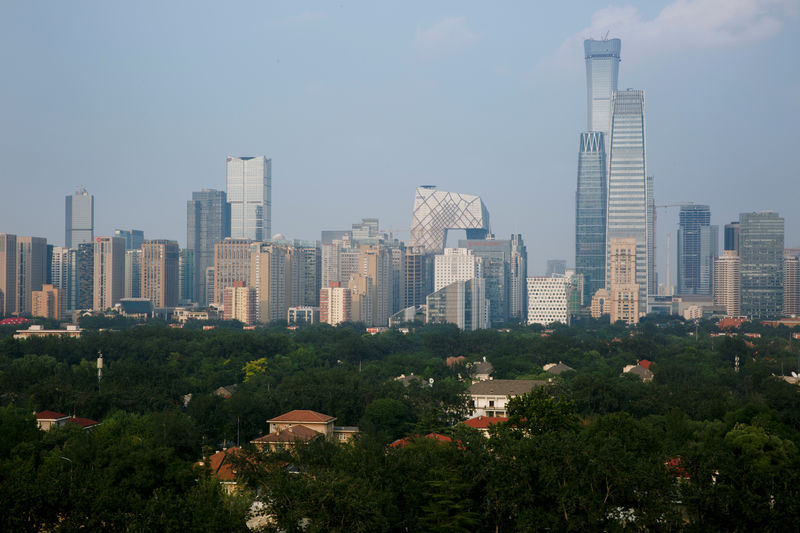By Kevin Yao and Fang Cheng
BEIJING (Reuters) - China's economy is showing signs of cooling further as the U.S. prepares even tougher trade tariffs, with investment growth slowing to a record low and consumers turning more cautious about spending, data showed on Tuesday.
Fixed-asset investment expanded by a less-than-expected 5.5 percent in January-July, a result of Beijing's crackdown on lavish local government borrowing for projects to boost growth.
Industrial output also undershot expectations, weighed down by pollution curbs and the uncertain trade outlook, adding to expectations that authorities will roll out more policy stimulus measures.
With the trade war threatening more pressure on China's already slowing economy, Beijing has shifted its focus to boosting domestic demand and is taking a more measured approach in its campaign to reduce financial risks and debt, which has pushed up borrowing costs and triggered a rising number of defaults.
The government has pledged to ramp up spending on railways and roads -- its traditional "go-to" approach when the economy slows -- while the central bank is pumping more money into the system and urging banks to offer more loans at cheaper rates to small businesses.
New yuan loans exceeded expectations in July, statistics showed on Monday, in one of the few bright spots in the most recent data.
"Admittedly, infrastructure spending may soon bottom out given the recent shift toward a looser fiscal stance and monetary easing should eventually drive a turnaround in credit growth," Julian Evans-Pritchard, senior China economist at Capital Economics, wrote in a note.
"However, these are unlikely to put a floor beneath economic growth until the middle of next year."
With the economy shifting into lower gear even without a trade shock, Capital Economics has predicted China's central bank will soon cut its official lending rate for the first time since 2015, though most analysts predict a more modest but steady stream of support measures in coming months.
The Shanghai "Nifty 50" stock index (SSE50) fell about 0.8 percent after the disappointing data, which added to a sour mood in global financial markets.
WEAKENING DOMESTIC DEMAND
The pace of fixed asset investment was the weakest on record going back to early 1996, according to data on Reuters Eikon. Investment had been expected to grow 6.0 percent in the first seven months of the year, steady from January-June.
For July, fixed-asset investment grew 3.0 percent from a year earlier.
Retail sales also missed expectations, with Chinese consumers more reluctant to spend on everything from cosmetics and other everyday goods to big-ticket items such as home appliances and furniture.
Sales rose 8.8 percent in July from a year earlier, below an expected 9.1 percent and down from 9.0 percent in June, despite a broad import tax cut that kicked in last month.
It was not clear if consumer reluctance was due to softening local conditions or worries about the U.S. trade war. A Reuters straw poll of Chinese consumers found nearly one in three want to stop buying U.S. products now and some are already boycotting made-in-America goods.
Industrial output also failed to pick up as expected. It rose 6.0 percent in July, missing analysts' estimates for 6.3 percent and unchanged from June.
While China's trade and inflation have shown limited impact from U.S. tariffs so far, it is early days. Business surveys point to weakening export orders and there are concerns that a protracted trade battle could produce a sharper Chinese slowdown than expected just a few months ago.
China and the United States have slapped tariffs on each other's goods and more are due to kick in next week, with few signs that either side is in the mood to compromise.
SOME BRIGHTER SPOTS
In one of the few encouraging spots in the data, private sector fixed-asset investment rose 8.8 percent in January-July, picking up from 8.4 percent in the first half. It accounts for about 60 percent of overall investment in China.
But growth in infrastructure spending, a powerful economic driver, slowed to 5.7 percent in the first seven months from 7.3 percent.
Still, there were early signs that Beijing's shift to supporting growth may already be offering some cushion.
Real estate investment jumped 13.2 percent in July on-year, the fastest in nearly two years and higher than June's 8.4 percent rise, according to Reuters calculations.
New construction starts jumped 32.4 percent on-year, likely buoyed by stronger home sales, improved funding conditions for cash-strapped developers and the government's heavy spending on public housing.
Infrastructure loans also rebounded sharply in July to 172.4 billion yuan ($25.05 billion) the banking and insurance regulator said on Saturday.
The Politburo said last month it would achieve this year's target of around 6.5 percent, despite risks to growth. Last year it expanded 6.9 percent.
The shift to stimulus measures has raised fears among some China watchers that Beijing is returning to its old playbook of debt-fueled growth, undermining its multi-year push to reduce riskier lending practices and a mountain of debt.
But unless conditions deteriorate markedly, most economists believe Beijing will stick with its deleveraging campaign, albeit at a more cautious pace, as it waits to see how the trade dispute plays out.
For now, a return to massive money printing like that seen during the global financial crisis, which would risk a further debt blowout, does not seem to be on the cards.
